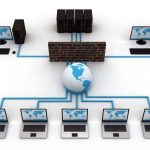 A computer network is defined as interconnected collection of autonomous computers. Computer are said to be interconnected, if they able to exchange information. Connection is physically established through cables, lasers, microwaves, fiber optics and communication satellite.
A computer network is defined as interconnected collection of autonomous computers. Computer are said to be interconnected, if they able to exchange information. Connection is physically established through cables, lasers, microwaves, fiber optics and communication satellite.
What we mean by the word ‘autonomous’? Autonomous is any one computer in the network that cannot forcibly start, stop or control another computer in the network. In other words, the computer works independently. This is in sharp contrast to a computer with full control over many slaves. This is not a computer network.
Now there is another term ‘distributed computing’ which is closely related with networks. A distributed computer system differ from a computer network in one as aspect that in a distributed system, the existence of multiple autonomous computers is not visible to the user. The user can type commands that are executed in a different machine selected by the operating system. It is the job of the operating system to select free processor, find and move all the required input files to that processor and send the result to the user.
In a network, the user must logon to the network, locate files and submit jobs. The network management has to be handled personally by the user. In a distributed system, all jobs are done automatically by the system without the user’s knowledge. Hence the distributed system is a special case of network system, one whose operating system has a high degree of transparency.
Objectives of Computer Network
Right from the day of computer automation, a computer has developed computer in each department. For example, the task can be to keep of track off inventories, monitor productivity and maintain accounts. Initially, this computer in different department works as an isolation from other computer. These provided the necessary computer assistance in the activities pertaining to the respective department. It was not possible to share information among the departments. As a result, the information was replicated wherever needed. This increased redundancy caused increased in storage space, less data consistency etc.
Hence, at a point it was decided to connect the computers in various departments to extract the information and correlate information about the entire company. The following are the objectives of the computer networks.
1. Resource sharing is the main objective of the computer network. The goal is to provide all the program, date and hardware is available to everyone on the network without regard to the physical location of the resource and the users.
2. The second objective is to provide the high Reliability. It is achieved by replicating the files on two or more machines, so in case of unavailability (due to fail of hardware) the other copies can be used.
3. Computer organization has helped organization in saving money. This is due to the fact that the small computer has much better price to the performance ratio comparison than the large computer like mainframe. Mainframe computer are approximately ten times faster that the microcomputers, but they cost thousands times more. As a result of this imbalance, organization has preferred to install interconnected microcomputer connected to the mainframe computer.
4. Computer network have provided means to increase system performance as the work load increases (load balancing). In the days of mainframe when the system was full it was to replace with the other large mainframe computer, usually at and expensive rate not convenience for user.
5. Computer network help people who live or work apart to report together. So, when one user prepared some documentation, he can make the document online enabling other to read and convey their opinions. Thus computer network is a powerful communication medium.
6. Only authorized user can access resource in a computer network. Users are authenticated by their user name and password. Hence it is not possible to access the data without proper account. This increases security.
Application of Networks: Some of the network applications of the different fields are the following.
1. Marketing and sales: Marketing professional uses them to collect exchange and analyze data relating to customer needs and product development cycles.
Sales application includes Teleshopping, which uses order entry computers or telephone connected to an order processing network, and online reservation services for railways, hotels, airlines, restaurants theatre etc.
2. Financial services: It include credit history searches, foreign exchange and investment services and electronic fund transfer (EFT), which allow a user to transfer money without going to bank.
3. Manufacturing: computer networks are used today in many aspects of manufacturing, including the manufacturing processes itself. Two aspects that uses network to provide essential services are computer Assisted design (CAD) and computer Assisted manufacturing (CAM), both of which allow multiple user to work on a project simultaneously.
4. Electronic Messaging: E-mails transfer the messages between two and more users in a network. With this application user can transfer the information in the form of text, picture and voice.
5. Directory Services: It allows list of files to be stored in central location to speed up the world wide search operation. E.g. search engines like Google, Britannia, and Yahoo etc.
6. Information Services: It includes Bulletin Boards and data bank. A ‘www’ site offering the technical specification for a new product in a information services.
7. Electronic Data Exchange (EDI): EDI allows business information (including documents such as purchase orders and services) to be transferred without using paper.
8. Teleconferencing: It allows conference to occur without the participant being in the same location. It includes:
Text Conferencing: Participant communicates through their keywords and computer monitors.
Voice Conferencing: Participant at a number of locations communicates simultaneously through phone (talk).
Video Conferencing: Participant can see as well as talk to another.
9. Cellular Telephone: Wireless phone communication even while travelling through long distance.
10. Cable TV: This is widest usable thing today throughout the world.







